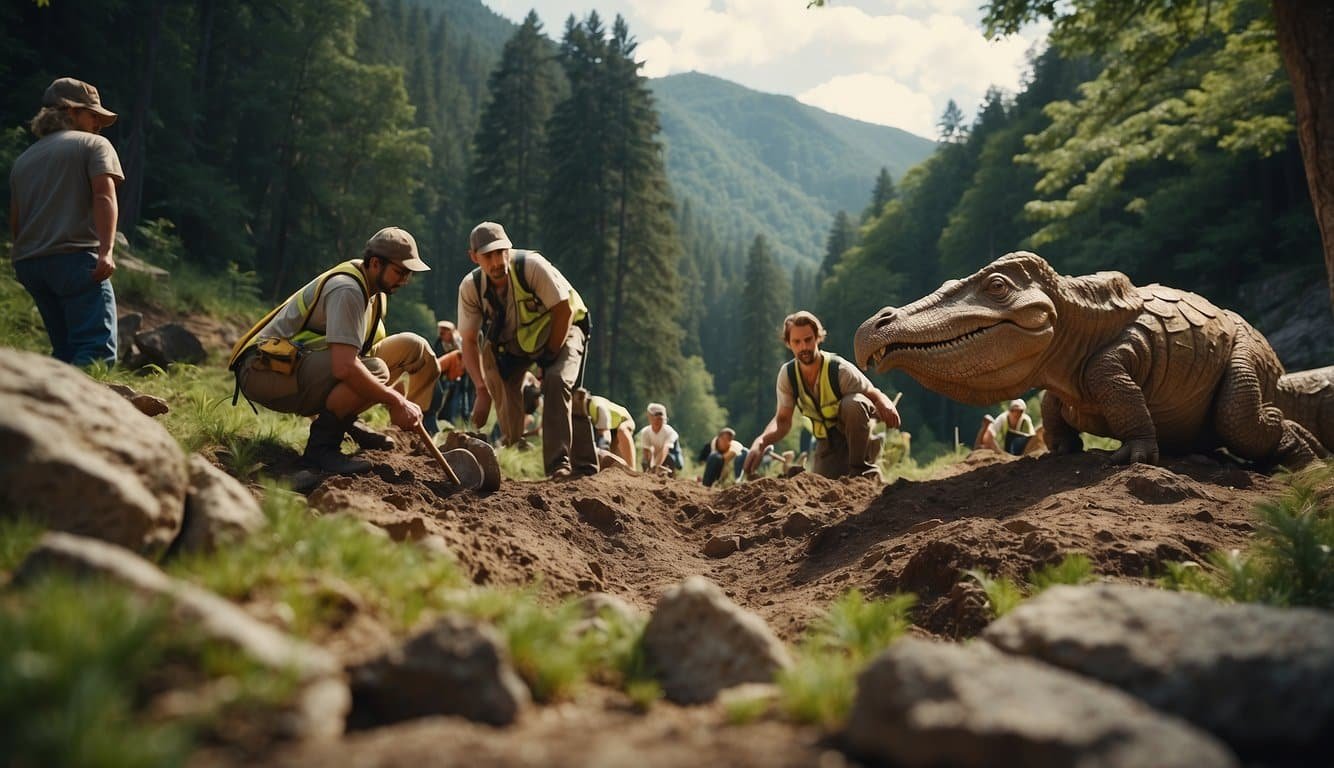Overview of Parasaurolophus
Parasaurolophus, a remarkable dinosaur known for its unique cranial crest, roamed the lands of North America during the Late Cretaceous period. This herbivorous species stood out among its peers due to its distinctive headgear and its potential to produce sounds.
Distinctive Features
The most striking feature of the Parasaurolophus is its large, elaborate crest. Shaped somewhat like a tube, the crest could reach lengths of over half a meter and is believed to have served multiple functions. For some hadrosaurids, it may have been a visual signal used to communicate within the species, while others hypothesize the crest functioned as a resonating chamber for producing sounds, perhaps for social calls or mate attraction.
The anatomy of the crest, with its long and complex nasal passages, implies these dinosaurs could have created deep, resonant noises that would carry across the prehistoric landscapes they inhabited. The Parasaurolophus was bipedal but could also move on all fours, which likely helped in foraging at different heights.
Research into the stratigraphic distribution of hadrosaurids reveals that Parasaurolophus lived in a variety of environments, showcasing adaptability and resilience as a species.
Fossils and scientific reconstructions continue to enhance our understanding, correcting past misconceptions about this fascinating creature. For instance, newer studies, such as those on the type specimen of Parasaurolophus walkeri, offer insights into the life and challenges faced by these ancient animals, including evidence of paleopathological lesions that give a glimpse into their health and well-being.
Fossil Discoveries and Locations

Parasaurolophus, the remarkable crested dinosaur, has left behind a trail of intriguing fossils across North America, illuminating the understanding of its existence during the Late Cretaceous period.
North American Findings
In the rugged Badlands of Alberta, Canada, the Dinosaur Park Formation has yielded significant finds of Parasaurolophus remains. Renowned paleontologists have studied the diverse dinosaur fauna here, with the Royal Ontario Museum playing a crucial role in unearthing and researching these fossils. These discoveries, nestled within the layers of sedimentary rock, provide insight into the prehistoric ecosystems where Parasaurolophus roamed.
Further south, in the United States, the fossil record of Parasaurolophus expands through New Mexico and Utah. Notably, the Fruitland Formation has surfaced as an important site, revealing new cranial remains that contribute to the rediagnosis and understanding of Parasaurolophus species. Utah’s contribution to Parasaurolophus research is also significant, with the remarkable braincase discoveries that further unravel the biostratigraphy and anatomical peculiarities of this hadrosaurid.
Expansion of Knowledge
Parasaurolophus’s past comes to life not only through fossil location but also via the stories told by the very bones themselves. For instance, an analysis of the type specimen of Parasaurolophus walkeri, found over a century ago, reveals detailed paleopathological lesions, offering a window into the challenges this dinosaur faced during its life. Meanwhile, ontogenetic studies highlight the growth and development of their distinctive crests, with juvenile specimens providing indispensable clues on crest formation and its evolutionary significance.
Each new discovery, whether a majestic skull or a fragmented bone, extends the narrative of Parasaurolophus, showcasing an ever-expanding tableau of dinosaurian life that continues to capture the curiosity of scientists and enthusiasts alike.
Anatomical Insights

The Parasaurolophus, a well-known herbivorous dinosaur of the ornithopod family, boasted unique features like a tubular crest on its skull which have perplexed scientists for years. A closer look at its skull, teeth, and overall skeleton provides insights into its lifestyle and feeding habits.
Crest Functionality
The tubular crest that defines Parasaurolophus is not just a head adornment; it’s a window into the dinosaur’s behavior. Studies suggest that the crest’s intricate nasal passages could have played a role in vocalization, helping these dinosaurs communicate with one another across the vast Cretaceous landscapes. Some paleontologists posit that it may have also served as a visual display for attracting mates or asserting dominance within their social groups.
The distinctive crest could even have had a role in thermoregulation, potentially helping to regulate body temperature. As for its composition, the crest is an extension of the skull’s skeleton, housing elongated nasal passages that loop up through the crest before exiting the nostrils.
Dietary Habits
An examination of Parasaurolophus’s teeth and jaws brings their herbivorous diet into focus. Their dental setup included batteries of tightly-packed teeth designed to grind through the tough vegetation of their era, ranging from ferns to conifers. As they wore down, these teeth would be replaced, ensuring the dinosaurs could continue to process their plant-based diet efficiently.
The nature of their teeth and the muscular structure inferred from the skull and skeleton suggests they likely employed a methodical chewing action, necessary for breaking down fibrous plant materials. This herbivore’s diet and feeding habits point to a life spent browsing on the diverse Cretaceous flora, relying on a keen sense of smell—potentially enhanced by their crest—to avoid the era’s predators.

